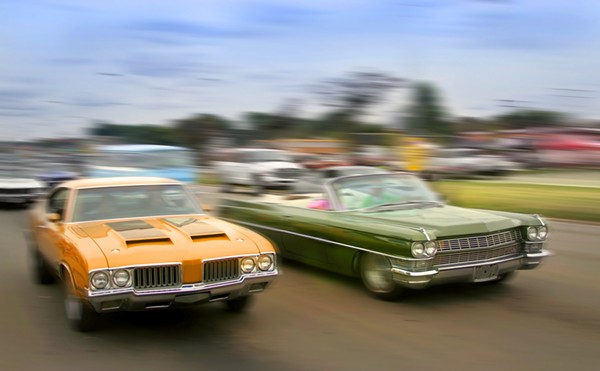For Alfred Hitchcock, a chandelier is not just a chandelier. In the most fascinating scene in the otherwise mundane courtroom drama The Paradine Case, it's the symbol that literally divides Louis Jourdan's effeminate valet and Gregory Peck's inquisitive barrister in their first taut encounter. In subsequent edits, its stalactite shards gleam above their heads in medium shots and two shots like daggers.
The dialogue the men exchange is important, but the star of the scene is the chandelier. We know the crystals won't fall and strike them, much like we know the taxidermic birds won't swoop and attack Anthony Perkins in Psycho or the stuffed bear, baring its fangs at James Stewart in the foreground of the best scene in 1956's The Man Who Knew Too Much, won't suddenly come alive. But in these isolated moments, the placement of the camera in Hitch's meticulous mise-en-scène adds another eerily suspenseful dimension to the scene at hand. These elements can be found in droves in Hitchcock's cinema if you want to look for them, or you can take his pictures, as most audiences do, as pleasurable diversions.
By simultaneously playing both auteur and entertainer, Hitch ensured that his legacy was twofold: He was at once an experimental formalist and a classic studio storyteller, a pop-culture brand and a high-art bellwether. Through his playful cameo appearances, eponymous television show and shrewd public persona, he was a master marketer, cultivating an indelible image through silhouette alone. Most people couldn't tell you what John Ford or Howard Hawks even looked like, but, by 1958, Hitchcock had his own board game, the Clue knock-off titled Why? (Hitchcock as merchandise magnet continues to this day. Look no further than Mattel's freakish Tippi Hedren Barbie, complete with birds pecking away at all sides, released this year to celebrate the 45th anniversary of Hitch's horror classic. Only $44.95!)
At the same time, Hitchcock was an erudite cineaste who could match theoretical wits with the best of them. Remarkably cognizant of both his mistakes and successes, Hitchcock stripped down the cartoon he created of himself in a couple of lengthy, candid conversations with Francois Truffaut and Peter Bogdanovich, in which he comes off as both humble and arrogant, and often resembles a magician revealing his tricks (Literally: Read Truffaut's seminal interview book to learn how Hitchcock achieved the effect of the glowing milk glass in Suspicion, for instance).
While Hitch's status as an important film artist is no longer in dispute — thanks largely to the pioneering Truffaut — it helps to remember his legacy as this art-entertainment dichotomy, both in Hitchcock's twin personalities and his conflicting formal practices. If you can bear a Freudian analogy, Hitchcock's cinema represented the duality of the complacent ego — the structured nature of his stories, fully in tune with classical storytelling conventions — and the suppressed id: those self-conscious moments of pure cinema that disrupt the director's invisibility and remind us we're watching a film. The Psycho shower scene, with its 50 cuts in three minutes, is an id moment if there ever was one, ditto to the flashes of red in Marnie, the how-did-he-do-that crane shot in Notorious, and the surrealist dream sequences of Spellbound and Vertigo. But these key set pieces would not have their timeless impact without the structured realities surrounding them; Hitchcock's status as a bravura showman necessarily had to coexist with his ability to craft skeletons of mass-audience entertainment on which to hang his formalist neuroses.
New DVD releases from MGM and Universal, as well as the first American printing of an essential Hitch text called The Alfred Hitchcock Story, lend credence to the director's transcendent dual appeal. Originally released in Britain in 1999, Ken Mogg's Alfred Hitchcock Story is the coffee-table book to end them all. Like Hitchcock's films, it will appeal to both scholars and laymen, offering accessible trivia and deep analysis. Mogg looks at Hitchcock's work as both commercial products and artistic ventures, noting in his introduction Hitchcock's "ambition to create 'art' movies that were also 'popular' movies."
Every page is glossy and peppered with movie stills, lobby cards, posters both foreign and domestic, and whatever other detritus Mogg could find to flesh out his painstakingly comprehensive study. While many readings of Hitchcock neglect his early period, Mogg acknowledges the roughly 18 movies he made before 1934's The Man Who Knew Too Much, giving generous space to such hard-to-find works as The Farmer's Wife, Elstree Calling and Waltzes from Vienna and linking these formative films to the director's subsequent masterpieces. A complete retrospective, The Alfred Hitchcock Story even spends a considerable amount of ink on Alfred Hitchcock Presents, Hitch's line of mystery literature and his unrealized film projects.
On to the new DVDs: MGM's wonderful Alfred Hitchcock Premiere Collection boasts eight films in a scrapbook-like binder, housed in an acrylic case with stenciled lettering. This is the box set of the future, folks. It includes Rebecca, Notorious and Spellbound, so there's no longer a need to shell out 50 bucks a pop on eBay for the out-of-print Criterion releases of said titles. Better yet, the collection features, for the first time in quality Region 1 transfers, early classics such as The Lodger: A Story of the London Fog (Hitchcock's breakthrough silent film, still strikingly modernist), Sabotage (one of the darkest visions of terrorism he ever filmed), Young and Innocent (an amusing, romantic adventure, undervalued because the story's essentially the same as that of The 39 Steps and Saboteur) and The Paradine Case (dig the chandelier, but otherwise, meh). The previously available Lifeboat rounds out the set, whose extras include commentaries on every disc, featurettes on a few of them and audio excerpts from Hitchcock's Truffaut and Bogdanovich interviews.
Universal has also done its share to honor Hitchcock's 100th, with two-disc "Legacy Series" releases of Rear Window, Vertigo and Psycho. If you already own Universal's Alfred Hitchcock Masterpiece Collection, then you have these movies and probably don't need to splurge a second time. But the extras are delectable and, once again, traverse the popular-artistic dichotomy that was in full bloom in Hitch's peak period. The featurette In the Master's Shadow, on the Psycho edition, is an absorbing look at the myriad filmmakers who have been influenced by — or blatantly cribbed from — Hitchcock. Obsessed with Vertigo traces the once-neglected 1958 masterwork through its re-evaluation and rigorous restoration process, and the documentary Partners in Crime provides a helpful look at the director's favorite collaborators, such as composer Bernard Hermann and title designer Saul Bass.
Like many great artists, Hitchcock was a riddle wrapped in a mystery inside an enigma, a self-perpetuating paradox who, like his dual embrace of the art film and the popcorn movie, continues to confound historians about who he really was 28 years after his death. (See the Times Online article "Hitchcock: Monster or Moralist?" — published in September.) The master can rest assured that no matter how many books are published or how many DVDs are released in the next hundred years, we'll still be discussing and debating Alfred Hitchcock in the year 2108.
John Thomason is freelance writer. Send comments to [email protected]




